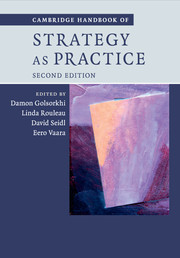Book contents
- Frontmatter
- Contents
- List of figures
- List of tables
- List of boxes
- List of contributors
- Preface to the Second Edition
- Introduction: what is strategy as practice?
- Part I Ontological and Epistemological Questions
- 1 Practice in research: phenomenon, perspective and philosophy
- 2 Epistemological alternatives for researching strategy as practice: building and dwelling worldviews
- 3 Making strategy: meta-theoretical insights from Heideggerian phenomenology
- 4 Constructivist paradigms: implications for strategy-as-practice research
- 5 Constructing contribution in strategy-as-practice research
- 6 The ongoing challenge of developing cumulative knowledge about strategy as practice
- 7 Practical relevance of practice-based research on strategy
- Part II Theoretical Resources: Social Theory
- Part III Theoretical Resources: Organization and Management Theories
- Part IV Methodological Resources
- Part V Substantive Topic Areas
- Index
- References
5 - Constructing contribution in strategy-as-practice research
from Part I - Ontological and Epistemological Questions
Published online by Cambridge University Press: 05 October 2015
- Frontmatter
- Contents
- List of figures
- List of tables
- List of boxes
- List of contributors
- Preface to the Second Edition
- Introduction: what is strategy as practice?
- Part I Ontological and Epistemological Questions
- 1 Practice in research: phenomenon, perspective and philosophy
- 2 Epistemological alternatives for researching strategy as practice: building and dwelling worldviews
- 3 Making strategy: meta-theoretical insights from Heideggerian phenomenology
- 4 Constructivist paradigms: implications for strategy-as-practice research
- 5 Constructing contribution in strategy-as-practice research
- 6 The ongoing challenge of developing cumulative knowledge about strategy as practice
- 7 Practical relevance of practice-based research on strategy
- Part II Theoretical Resources: Social Theory
- Part III Theoretical Resources: Organization and Management Theories
- Part IV Methodological Resources
- Part V Substantive Topic Areas
- Index
- References
Summary
As with all knowledge-creating communities, strategy-as-practice scholarship constitutes itself through the production of networks of texts that frame and focus topics of interest. SAP scholarship seeks to advance knowledge in ‘the doing of strategy: who does it, what they do, how they do it, what they use, and what implications this has for shaping strategy’ (Jarzabkowski and Spee 2009: 69). In mapping the growing work in this area (Jarzabkowski and Spee 2009; Vaara and Whittington 2012), reviews have shown that recent SAP texts advance a research agenda developed in foundational publications (such as those of Jarzabkowski, Balogun and Seidl 2007; Johnson et al. 2007; and Whittington 2006) and contribute to strategic management by moving ‘beyond the strategy discipline's usual focus on economic performance per se’ (Vaara and Whittington 2012: 3) to actively integrate social theories of practice and broaden the scope of outcomes regarded as important to study.
Although these reviews discern specific findings and a general understanding of what knowledge is being produced, they yield little insight into how SAP authors position their work and make claims of knowledge regarded as contributions by the academic community. Understanding how authors craft arguments to persuade an intended audience is important, because written texts ‘do not simply array “facts” and evidence logically’ (Locke and Golden-Biddle 1997: 1060) but, rather, use certain rhetorical strategies to convey novelty and even surprise vis-à-vis existing knowledge (Davis 1971).
In order to consider how strategy-as-practice research constructs opportunities for contribution, its written texts must be regarded as ‘first-order data’ and examined directly for rhetorical strategies. For this purpose, we turn our analytic attention to the genre of journal articles that are the location of crucial public discourse among researchers (Winsor 1993; Yearley 1981; Zuckermann 1988). Our sample consisted of seventy empirical SAP studies published in peer-reviewed journals from 2002 to early 2014. We divided our sample into two subsets in order to analyse the development of contribution constructions over time: (1) the first wave contained articles published from 2002 to 2008; and (2) the second wave contained articles published from 2009 to 2014. To guide our analysis, we drew on an extant framework of constructing opportunities for contribution in management and organization studies (Locke and Golden-Biddle 1997).
- Type
- Chapter
- Information
- Cambridge Handbook of Strategy as Practice , pp. 95 - 110Publisher: Cambridge University PressPrint publication year: 2015
References
- 1
- Cited by

